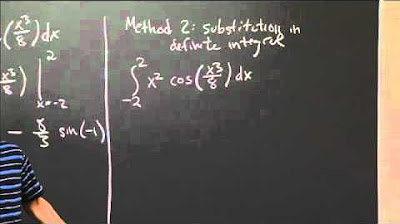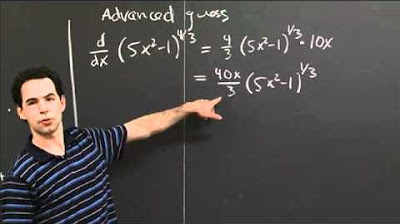Definite Integrals of tan(x) | MIT 18.01SC Single Variable Calculus, Fall 2010
TLDRIn this recitation, the professor discusses the application of the Fundamental Theorem of Calculus to compute definite integrals of the function tan(x). The class is guided through the process of finding the antiderivative of tan(x), which is ln|cos(x)|, and using it to evaluate the integral from pi/6 to pi/3. The professor corrects a mistake and simplifies the result to 1/2 ln(3). For the integral from -pi/3 to pi/3, the professor highlights the geometric interpretation and the property of tan(x) being an odd function, leading to a conclusion that the integral sums to zero. The session emphasizes the utility of calculus tools over Riemann sums for evaluating definite integrals.
Takeaways
- 📚 The lecture is focused on definite integration and the application of the fundamental theorem of calculus.
- 🔍 Two specific definite integrals are presented for the students to solve: one from pi/6 to pi/3 and another from -pi/3 to pi/3 of tan(x) dx.
- ⏸ The professor suggests pausing the video to work on the integrals independently before continuing with the explanation.
- 📉 The Riemann sum method is mentioned as a potential approach but is quickly dismissed due to the complexity with the function tan(x).
- 🛠 The fundamental theorem of calculus is introduced as the preferred tool for computing the definite integrals of tan(x).
- 📝 The antiderivative of tan(x) is identified as -ln|cos(x)|, which is used to evaluate the definite integrals.
- 🔄 The process involves taking the difference of the antiderivative evaluated at the bounds of the integral.
- 🤔 A mistake is made in the explanation, which is corrected to use -ln|cos(x)| instead of ln|cos(x)|.
- 📐 The geometric interpretation of the integral is used to explain why the second integral evaluates to zero, as tan(x) is an odd function and the areas cancel out.
- 📈 The first integral is computed by evaluating the antiderivative at the bounds and simplifying the result to 1/2 ln(3).
- 📚 The importance of using the fundamental theorem of calculus over Riemann sums for these types of integrals is emphasized for efficiency.
- 📝 The lecture concludes by highlighting the utility of the available mathematical tools for evaluating definite integrals without reverting to the Riemann definition.
Q & A
What is the main topic discussed in the recitation?
-The main topic discussed in the recitation is definite integration, specifically using the fundamental theorem of calculus to compute definite integrals of the function tan(x).
What is the fundamental theorem of calculus and how is it used in this context?
-The fundamental theorem of calculus is a powerful tool that allows us to compute definite integrals by finding an antiderivative of the function and then comparing two values of the antiderivative to find the integral's value.
What is the antiderivative of tan(x) mentioned in the script?
-The antiderivative of tan(x) is -ln(absolute value of cos(x)), which is used to compute the definite integrals in the script.
What is the process for computing the first definite integral in the script?
-The process involves taking the antiderivative of tan(x), which is -ln(absolute value of cos(x)), and then evaluating the difference of this antiderivative at pi/3 and pi/6.
Why is the use of Riemann sums not recommended for the function tan(x) in this script?
-Riemann sums are not recommended for tan(x) because it would be very difficult to compute due to the nature of the tangent function, and the fundamental theorem of calculus provides a more straightforward method.
What is the geometric interpretation used to simplify the second definite integral?
-The geometric interpretation used is that tan(x) is an odd function, and the integral over a symmetric interval around the origin will result in a cancellation of positive and negative areas, leading to an integral value of 0.
What is the final evaluated result for the first definite integral in the script?
-The final evaluated result for the first definite integral is 1/2 ln(3), after using logarithm rules to combine the terms.
Why does the professor correct the antiderivative from ln(absolute value of cos(x)) to -ln(absolute value of cos(x))?
-The professor corrects the antiderivative because the correct antiderivative of tan(x) is -ln(absolute value of cos(x)), which is crucial for accurately computing the definite integral.
What is the value of the second definite integral from -pi/3 to pi/3 of tan(x) dx, and why?
-The value of the second definite integral is 0 because the function tan(x) is odd and the interval is symmetric, causing the positive and negative areas to cancel each other out.
Why is it beneficial to have alternative tools to Riemann sums for evaluating definite integrals?
-Alternative tools like the fundamental theorem of calculus are beneficial because they allow for the evaluation of definite integrals without the complexity and difficulty associated with Riemann sums, especially for functions like tan(x).
Outlines
📚 Introduction to Definite Integrals and the Fundamental Theorem of Calculus
The professor begins by welcoming students back to a recitation session focused on definite integration, a topic recently introduced in lectures. The fundamental theorem of calculus is highlighted as a powerful tool for computing integrals. Two specific definite integrals are presented for the students to solve: one from pi over 6 to pi over 3 of tan x dx, and another from minus pi over 3 to pi over 3 of tan x dx. The professor suggests using the fundamental theorem instead of Riemann sums due to the complexity of the function tan(x). The antiderivative of tan(x), which is ln|cos(x)|, is used to evaluate the first integral by comparing values at the given limits. The process involves correcting a mistake regarding the sign of the antiderivative and then simplifying the result using logarithm rules to ln(√3) or 1/2 ln(3).
📉 Exploiting Symmetry in Odd Functions for Definite Integrals
In the second paragraph, the professor discusses the properties of the tangent function, which is an odd function, and its geometric interpretation. The integral from minus pi over 3 to pi over 3 of tan x dx is analyzed, noting that the positive and negative areas under the curve cancel each other out due to the symmetry of the function. This leads to the conclusion that the integral equals zero without the need for further computation. The professor emphasizes the advantage of using geometric reasoning and the fundamental theorem of calculus over the more cumbersome Riemann sums approach for evaluating definite integrals, especially for functions with such properties.
Mindmap
Keywords
💡Definite Integration
💡Fundamental Theorem of Calculus
💡Riemann Sums
💡Antiderivative
💡Natural Logarithm (ln)
💡Cosine Function (cos x)
💡Absolute Value
💡Odd Function
💡Geometric Interpretation
💡Logarithm Rules
Highlights
Introduction to the topic of definite integration and the fundamental theorem of calculus.
Presentation of two definite integral problems involving the tangent function.
Suggestion to pause the video to work on the integral problems independently.
Discussion of Riemann sums as a tool for definite integrals and their limitations for the given functions.
Introduction of the fundamental theorem of calculus as an alternative to Riemann sums.
Explanation of how to use antiderivatives to compute definite integrals according to the fundamental theorem.
Solution of the first integral using the antiderivative of tan(x), which is ln|cos(x)|.
Clarification of the correct antiderivative for tan(x) as -ln|cos(x)|.
Application of the fundamental theorem to find the value of the first integral by evaluating the antiderivative at the bounds.
Simplification of the integral result using logarithm rules to obtain ln(√3) or 1/2 ln(3).
Introduction of the second integral problem and a hint to use the same process as the first integral.
Geometric interpretation of the tangent function as an odd function and its symmetry.
Insight that the integral of an odd function over a symmetric interval equals zero.
Alternative approach to the second integral using geometric reasoning instead of computation.
Emphasis on the practicality of using the fundamental theorem over Riemann sums for these integrals.
Conclusion highlighting the utility of calculus tools in evaluating definite integrals efficiently.
Transcripts
Browse More Related Video

Definite Integral by Substitution | MIT 18.01SC Single Variable Calculus, Fall 2010

Antidifferentiation by substitution | MIT 18.01SC Single Variable Calculus, Fall 2010

Improper Integrals - Infinite Bounds

The Fundamental Theorem of Calculus - Example 1

Calculus - Lesson 16 | Indefinite and Definite Integrals | Don't Memorise

Worked example: Finding derivative with fundamental theorem of calculus | Khan Academy
5.0 / 5 (0 votes)
Thanks for rating: